Government General Mary Simon has announced 53 new Order of Canada appointments- one of Canada’s highest honours. This prestigious recognition celebrates individuals from diverse backgrounds for their outstanding contributions to Canada.
Established in 1067, the Order of Canada acknowledges remarkable achievements, dedication to the community and service to the nation, with over 7,600 people spanning various sectors invested in making a difference in Canada.
TORONTO, Canada, October 3, 2023 – The Structural Genomics Consortium (SGC) today announced that it has entered into a partnership with Shanghai Stock Exchange listed company HitGen Inc. ("HitGen", SSE: 688222.SH). HitGen will utilize its DNA-encoded library (DEL) technology platform, specifically OpenDEL™, to screen under-represented targets chosen by SGC.
Twenty years have now passed since the inception of the Structural Genomics Consortium (SGC), marking a remarkable journey dedicated to advancing knowledge through open science and collaboration.
On Wednesday, September 6th, the SGC Karolinska hosted the 20th Anniversary Symposium Europe in Stockholm. This symposium served as a continuation of the celebration that began in Toronto earlier in March, commemorating past achievements and charting the course for what lies ahead.
Toronto, Canada, September 28, 2023 – The Structural Genomics Consortium (SGC), a public-private partnership dedicated to accelerating drug discovery through open science and X-Chem, a global leader in innovative drug discovery services, announced that they have entered a collaboration aimed at creating new chemical tools to study human proteins.
| Probe | Negative control | |
 |
| 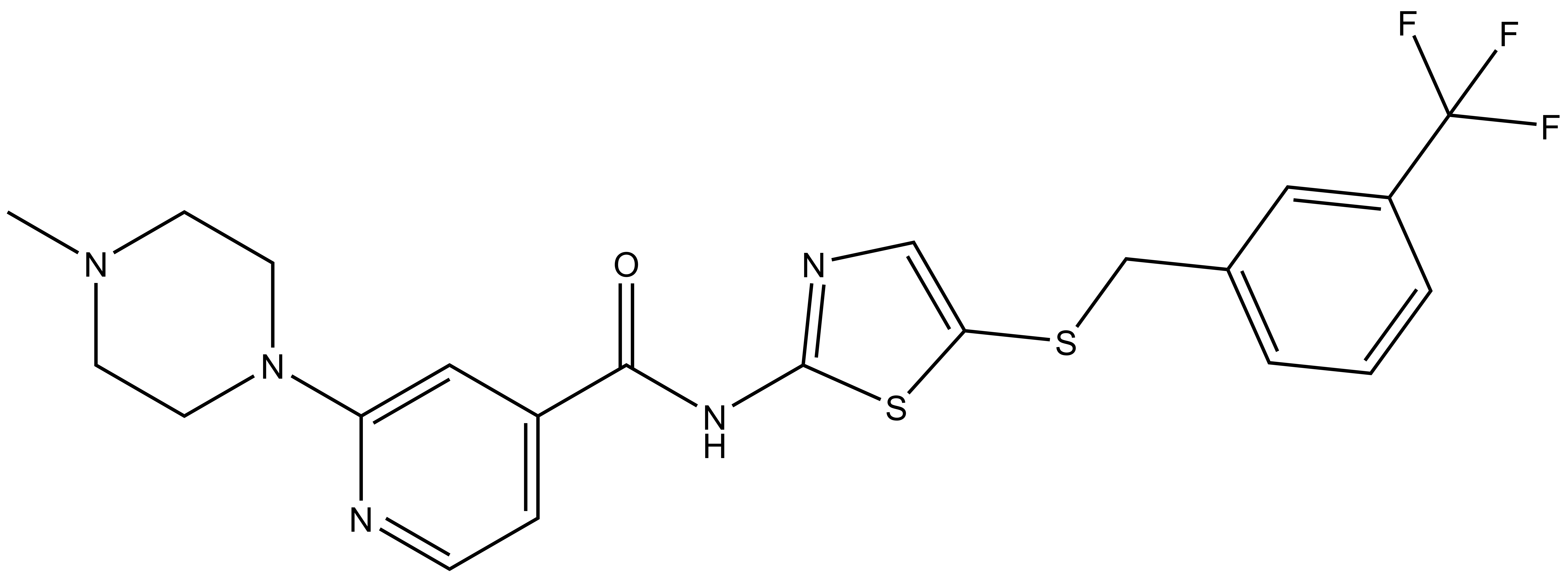 |
SGC-CAF382-1 |
| SGC-CAF268-1N |
From a library of SNS-032 analogs, we identified a potent and cell-active chemical probe (SGC-CAF382-1) that inhibits cyclin-dependent kinase-like 5 (CDKL5) and several cyclin-dependent kinases (CDK9, CDK16, CDK17, and CDK18). Comprehensive evaluation of kinome-wide selectivity confirmed that this chemical probe demonstrates good selectivity. A structurally similar analog (SGC-CAF268-1N) was characterized as a negative control that does not bind to CDKL5, CDK9, CDK16, CDK17, or CDK18 in corresponding cellular target engagement assays. SGC-CAF382-1 is devoid of GSK3 inhibition when used at an appropriate concentration. At nanomolar concentrations, our chemical probe promoted motor neuron survival when iPSC-derived motor neurons were subjected to ER stress. An orthogonal CDKL5 chemical probe, SGC-CDKL5/GSK3-1, represents a distinct chemotype with non-overlapping kinase off-targets that can be profiled in parallel. When used at ≤100 nM in cell-based assays, our chemical probe set can help the community further characterize the underexplored roles of CDKL5.
| Probe | Negative control | |
 |
|  |
SGC-CAF382-1 |
| SGC-CAF268-1N |
| Physical and chemical properties for SGC-CAF382-1 | |
| Molecular weight | 366.50 |
| Molecular formula | C16H22N4O2S2 |
| IUPAC name | N-(5-(((5-isopropyloxazol-2-yl)methyl)thio)thiazol-2-yl)piperidine-4-carboxamide |
| ClogP | 0.16 |
| PSA | 133.59 |
| No. of chiral centers | 0 |
| No. of rotatable bonds | 7 |
| No. of hydrogen bond acceptors | 5 |
| No. of hydrogen bond donors | 2 |
| Storage | Stable as a solid at room temperature. DMSO stock solutions (up to 10 mM) are stable at -20oC |
| Dissolution | Soluble in DMSO up to 10 mM |
| Physical and chemical properties for SGC-CAF268-1N | |
| Molecular weight | 493.57 |
| Molecular formula | C22H22F3N5OS2 |
| IUPAC name | 2-(4-methylpiperazin-1-yl)-N-(5-((3-(trifluoromethyl)benzyl)thio)thiazol-2-yl)isonicotinamide |
| ClogP | 2.33 |
| PSA | 114.90 |
| No. of chiral centers | 0 |
| No. of rotatable bonds | 8 |
| No. of hydrogen bond acceptors | 7 |
| No. of hydrogen bond donors | 1 |
| Storage | Stable as a solid at room temperature. DMSO stock solutions (up to 10 mM) are stable at -20oC |
| Dissolution | Soluble in DMSO up to 10 mM |
SMILES:
SGC-CAF382-1: O=C(C1CCNCC1)NC2=NC=C(SCC3=NC=C(C(C)C)O3)S2
SGC-CAF268-1N: O=C(NC1=NC=C(SCC2=CC=CC(C(F)(F)F)=C2)S1)C3=CC=NC(N4CCN(C)CC4)=C3
InChI:
SGC-CAF382-1: InChI=1S/C16H22N4O2S2/c1-10(2)12-7-18-13(22-12)9-23-14-8-19-16(24-14)20-15(21)11-3-5-17-6-4-11/h7-8,10-11,17H,3-6,9H2,1-2H3,(H,19,20,21)
SGC-CAF268-1N: InChI=1S/C22H22F3N5OS2/c1-29-7-9-30(10-8-29)18-12-16(5-6-26-18)20(31)28-21-27-13-19(33-21)32-14-15-3-2-4-17(11-15)22(23,24)25/h2-6,11-13H,7-10,14H2,1H3,(H,27,28,31)
InChIKey:
SGC-CAF382-1: MCLDWKVRXDHDEI-UHFFFAOYSA-N
SGC-CAF268-1N: RUYKDMMLESXEOA-UHFFFAOYSA-N
SGC-CAF382-1 was profiled in the DiscoverX scanMAX assay against 403 wild-type kinases at 1 μM. Only 7 kinases showed PoC <10 giving an S10(1 μM) = 0.017. When the PoC <35 fraction was examined, 10 kinases were included (S35(1 μM) = 0.024). Potential off-targets within the S35(1 μM) fraction and GSK3β (PoC = 51) were tested via biochemical enzymatic/binding assays plus NanoBRET target engagement assays for CDKL5, GSK3⍺, GSK3β, CDK9, CDK16, CDK17, and CDK18. Data corresponding with off-target kinase activity is shown in the table below.
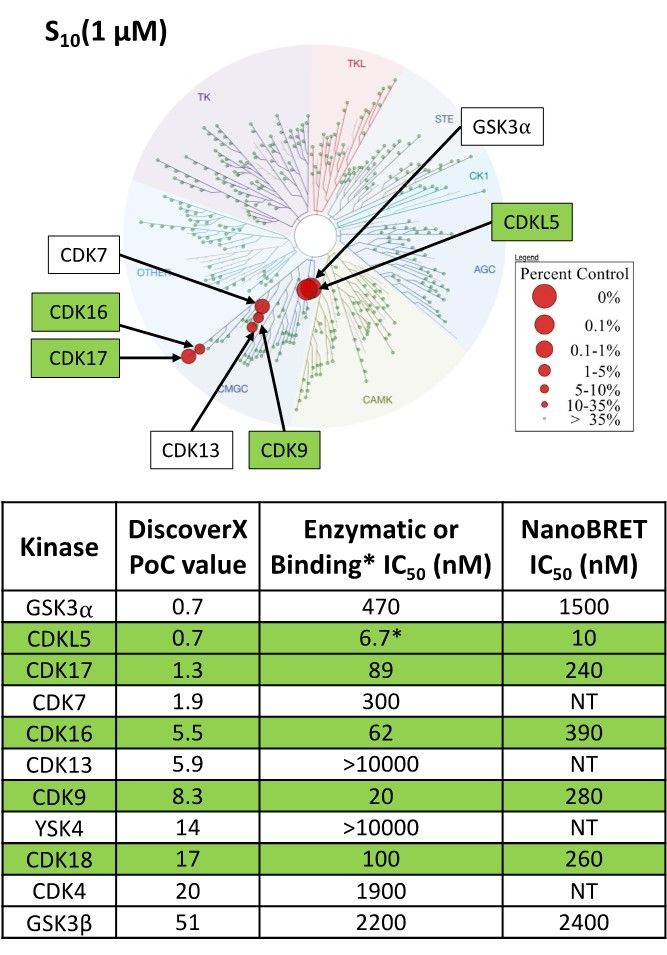
SGC-CAF268-1N was also tested in the DiscoverX scanMAX panel and 2 kinases had a PoC <35 (S35(1 μM) = 0.005). The negative control was evaluated in the corresponding NanoBRET assay for DYRK1B, the kinase that bound with the lowest PoC value in the kinome-wide screen. All results are in the table below.
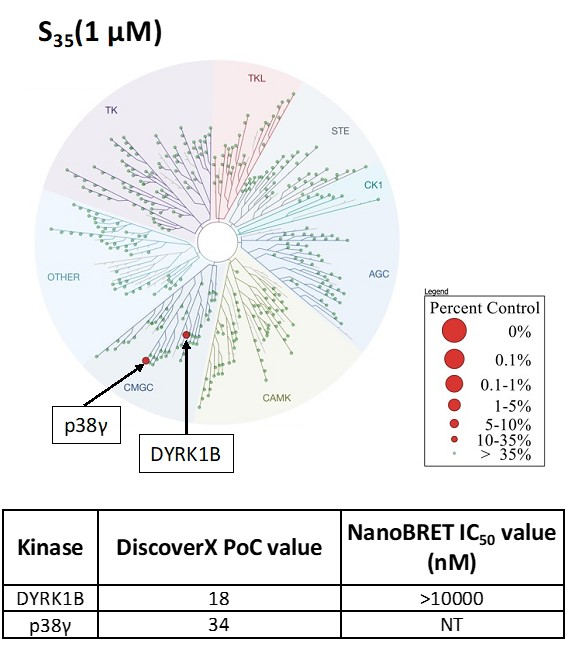
Biological activity summary:
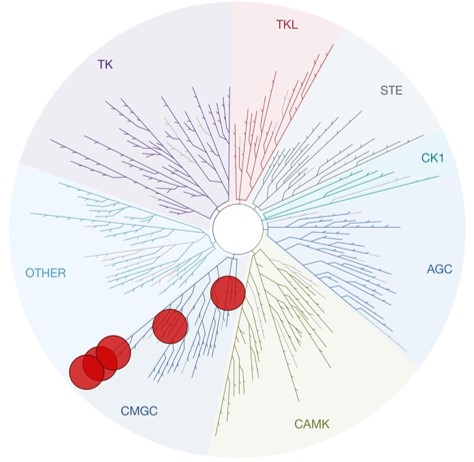
A NanoBRET assay was utilized to assess the binding affinity of SGC-CAF382-1 to CDKL5, CDK9, CDK16, CDK17, CDK18, GSK3⍺, and GSK3β. The negative control shows no binding affinity for CDKL5, CDK9, CDK16, CDK17, or CDK18.
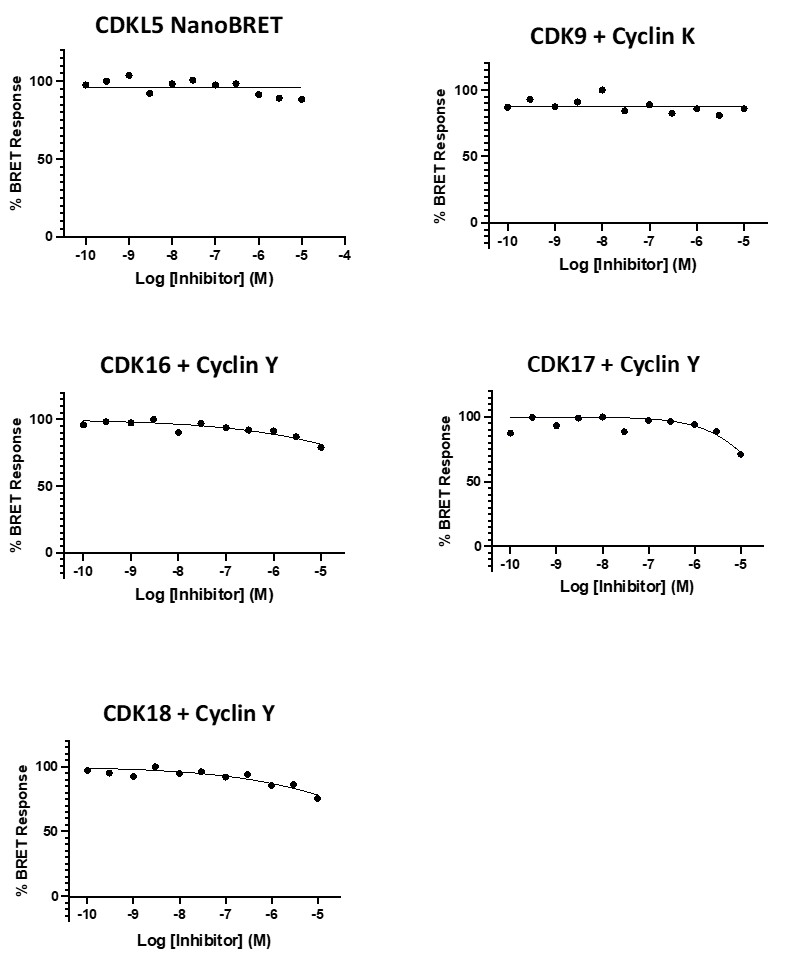
Castano, A.; Silvestre, M.; Wells, C. I.; Sanderson, J. L.; Ferrer, C. A.; Ong, H. W.; Liang, Y.; Richardson, W.; Silvaroli, J. A.; Bashore, F. M.; Smith, J. L.; Genereux, I. M.; Dempster, K.; Drewry, D. H.; Pabla, N. S.; Bullock, A. N.; Benke, T. A.; Ultanir, S.; Axtman, A. D. Discovery and characterization of a specific inhibitor of serine-threonine kinase cyclin dependent kinase-like 5 (CDKL5) demonstrates role in hippocampal CA1 physiology. Elife 2023, 12, e88206; doi: 10.7554/eLife.88206.
Castano, A.; Silvestre, M.; Wells, C. I.; Sanderson, J. L.; Ferrer, C. A.; Ong, H. W.; Liang, Y.; Richardson, W.; Silvaroli, J. A.; Bashore, F. M.; Smith, J. L.; Genereux, I. M.; Dempster, K.; Drewry, D. H.; Pabla, N. S.; Bullock, A. N.; Benke, T. A.; Ultanir, S.; Axtman, A. D. Discovery and characterization of a specific inhibitor of serine-threonine kinase cyclin dependent kinase-like 5 (CDKL5) demonstrates role in hippocampal CA1 physiology. BioRxiv 2023, doi: 10.1101/2023.04.24.538049.
This probe is available from Sigma.
| Probe | Negative control | |
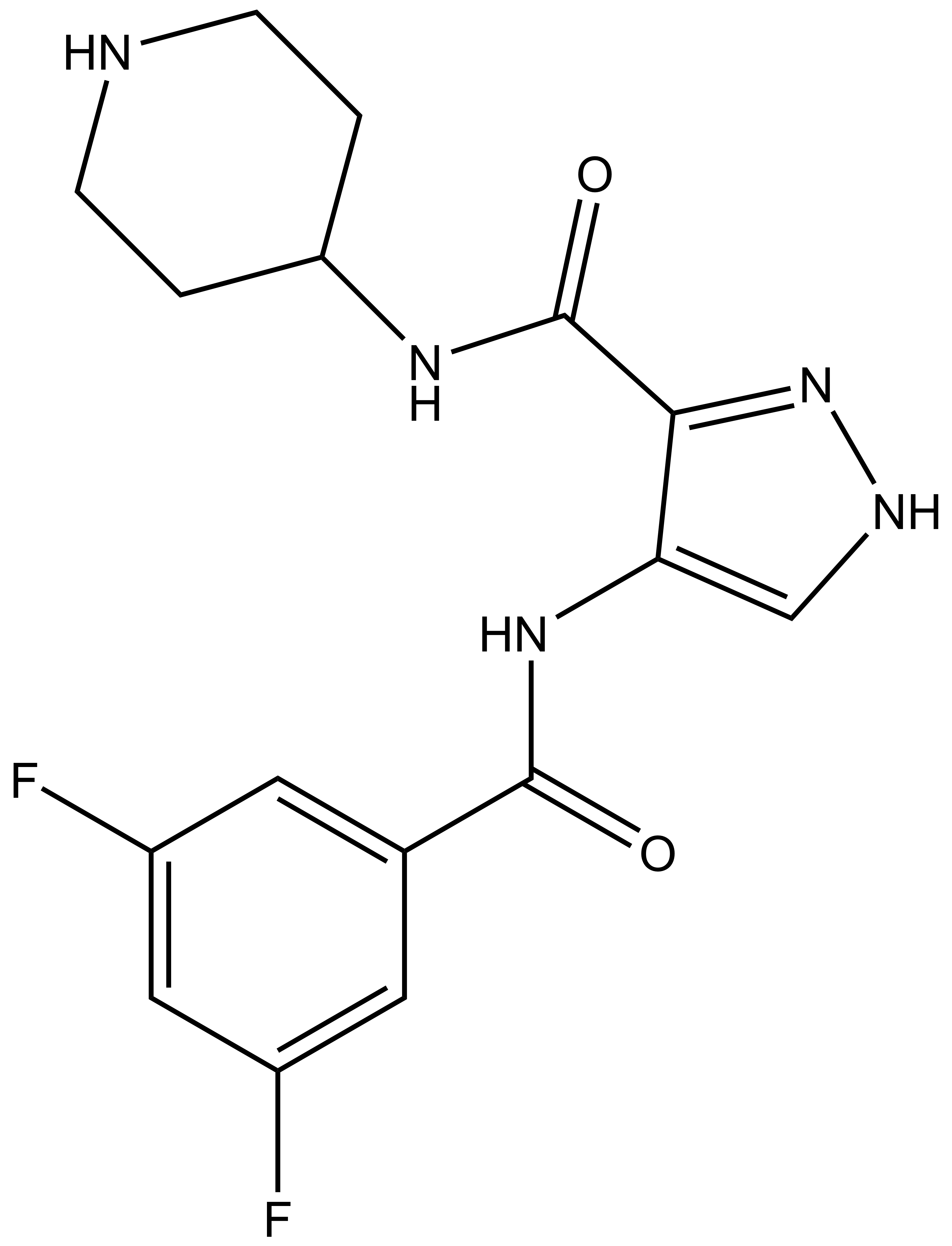 |
| 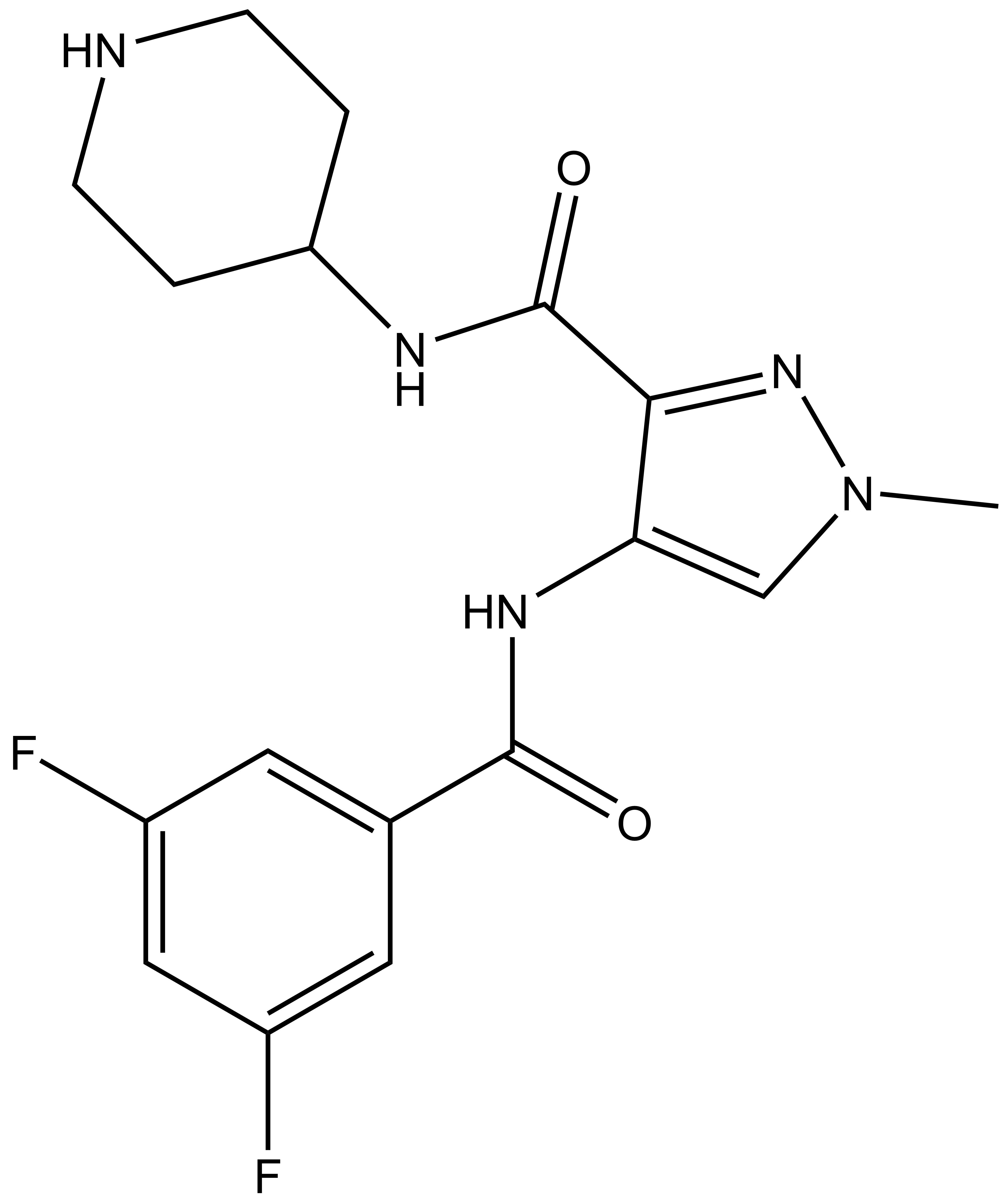 |
SGC-CDKL5/GSK3-1 |
| SGC-CDKL5/GSK3-1N |
From a library of AT-7519 analogs, we identified a potent and cell-active chemical probe (SGC-CDKL5/GSK3-1) that inhibits cyclin-dependent kinase-like 5 (CDKL5) and glycogen synthase kinase-3 (GSK3⍺ and β). Comprehensive evaluation of kinome-wide selectivity confirmed that this CDKL5/GSK3 probe demonstrates exceptional selectivity. A structurally similar analog (SGC-CDKL5/GSK3-1N) was characterized as a negative control that does not bind to CDKL5, GSK3⍺, or GSK3β in corresponding cellular target engagement assays. At nanomolar concentrations, our CDKL5/GSK3 chemical probe promoted motor neuron survival when iPSC-derived motor neurons were subjected to ER stress. We recommend use of a structurally related GSK3 chemical probe, SGC-GSK3-1, in tandem to interrogate those effects due to GSK3 rather than CDKL5 inhibition. An orthogonal CDKL5 chemical probe, SGC-CAF382-1, represents a distinct chemotype with non-overlapping kinase off-targets that can also be used in parallel. Our chemical probe set can be used by the community to further characterize the underexplored roles of CDKL5 and how inhibition of CDKL5 and GSK3 impacts downstream biology.
| Probe | Negative control | |
 |
|  |
SGC-CDKL5/GSK3-1 |
| SGC-CDKL5/GSK3-1N |
| Physical and chemical properties for SGC-CDKL5/GSK3-1 | |
| Molecular weight | 349.34 |
| Molecular formula | C16H17FN5O2 |
| IUPAC name | 4-(3,5-difluorobenzamido)-N-(piperidin-4-yl)-1H-pyrazole-3-carboxamide |
| ClogP | -0.33 |
| PSA | 98.91 |
| No. of chiral centers | 0 |
| No. of rotatable bonds | 6 |
| No. of hydrogen bond acceptors | 6 |
| No. of hydrogen bond donors | 4 |
| Storage | Stable as a solid at room temperature. DMSO stock solutions (up to 10 mM) are stable at -20oC |
| Dissolution | Soluble in DMSO up to 10 mM |
| Physical and chemical properties for SGC-CDKL5/GSK3-1N | |
| Molecular weight | 363.37 |
| Molecular formula | C17H19FN5O2 |
| IUPAC name | 4-(3,5-difluorobenzamido)-1-methyl-N-(piperidin-4-yl)-1H-pyrazole-3-carboxamide |
| ClogP | -0.32 |
| PSA | 88.05 |
| No. of chiral centers | 0 |
| No. of rotatable bonds | 6 |
| No. of hydrogen bond acceptors | 6 |
| No. of hydrogen bond donors | 3 |
| Storage | Stable as a solid at room temperature. DMSO stock solutions (up to 10 mM) are stable at -20oC |
| Dissolution | Soluble in DMSO up to 10 mM |
SMILES:
SGC-CDKL5/GSK3-1: O=C(NC1CCNCC1)C2=NNC=C2NC(C3=CC(F)=CC(F)=C3)=O
SGC-CDKL5/GSK3-1N: O=C(NC1CCNCC1)C2=NN(C=C2NC(C3=CC(F)=CC(F)=C3)=O)C
InChI:
SGC-CDKL5/GSK3-1: InChI=1S/C16H17F2N5O2/c17-10-5-9(6-11(18)7-10)15(24)22-13-8-20-23-14(13)16(25)21-12-1-3-19-4-2-12/h5-8,12,19H,1-4H2,(H,20,23)(H,21,25)(H,22,24)
SGC-CDKL5/GSK3-1N: InChI=1S/C17H19F2N5O2/c1-24-9-14(22-16(25)10-6-11(18)8-12(19)7-10)15(23-24)17(26)21-13-2-4-20-5-3-13/h6-9,13,20H,2-5H2,1H3,(H,21,26)(H,22,25)
InChIKey:
SGC-CDKL5/GSK3-1: NIHAFOURWLZLFN-UHFFFAOYSA-N
SGC-CDKL5/GSK3-1N: ODZBDODDFLVDQZ-UHFFFAOYSA-N
SGC-CDKL5/GSK3-1 was profiled in the DiscoverX scanMAX assay against 403 wild-type kinases at 1 μM. Only 4 kinases showed PoC <10 giving an S10(1 μM) = 0.01. When the PoC <35 fraction was examined, 11 kinases were included (S35(1 μM) = 0.027). Potential off-targets within the S35(1 μM) fraction were tested via biochemical enzymatic/binding assays plus NanoBRET target engagement assays for CDKL5, GSK3⍺, GSK3β, CDK16, and CDK17. Data corresponding with off-target kinase activity is shown in the table below.
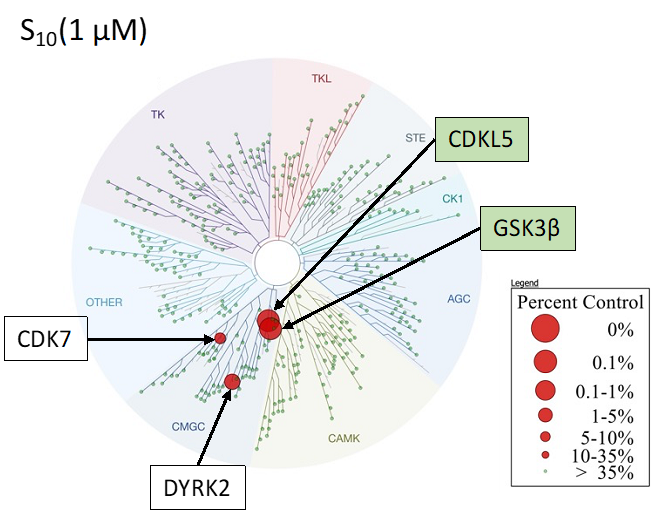
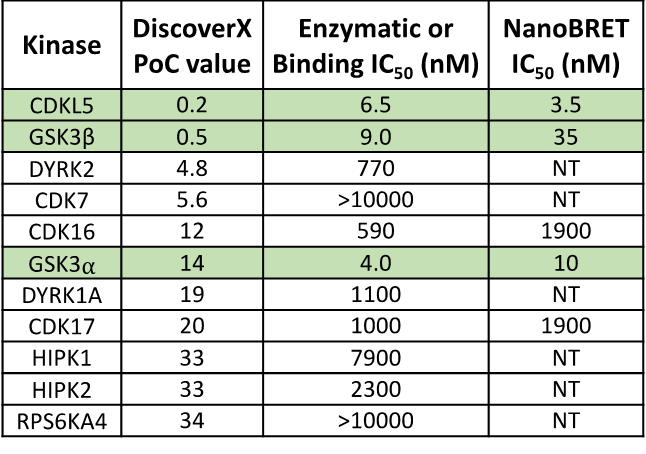
Figure 2: SGC-CDKL5/GSK3-1 was profiled in the DiscoverX scanMAX assay against 403 wild-type kinases at 1 μM and off-target kinases inhibited PoC <35 were tested in an orthogonal assay. Rows colored green are CDKL5, GSK3⍺, and GSK3β. No other kinases demonstrate enzymatic IC50 values within 30-fold of the GSK3β enzymatic IC50 value.

Figure 1: Kinome tree with CDKL5, GSK3⍺ and GSK3β highlighted as red circles. Illustration is reproduced courtesy of Eurofins DiscoverX (http://treespot.discoverx.com).
Biological activity summary:
A NanoBRET assay was utilized to assess the binding affinity of SGC-CDKL5/GSK3-1 to CDKL5, GSK3⍺, GSK3β, CDK16, and CDK17. The negative control shows no binding affinity for CDKL5, GSK3⍺, or GSK3β.



Figure 3: SGC-CDKL5/GSK3-1 was profiled in the CDKL5, GSK3⍺, and GSK3β NanoBRET assays.



Figure 4: SGC-CDKL5/GSK3-1N was profiled in the CDKL5, GSK3⍺, and GSK3β NanoBRET assays.
References
Ong, H. W.; Liang, Y.; Richardson, W.; Lowry, E. R.; Wells, C. I.; Chen, X.; Silvestre, M.; Dempster, K.; Silvaroli, J. A.; Smith, J. L.; Wichterle, H.; Pabla, N. S.; Ultanir, S. K.; Bullock, A. N.; Drewry, D. H.*; Axtman, A. D.* Discovery of a potent and selective CDKL5/GSK3 chemical probe that is neuroprotective. ACS Chem Neurosci 2023, 14, 1672–1685; 10.1021/acschemneuro.3c00135.
Ong, H. W.; Liang, Y.; Richardson, W.; Lowry, E. R.; Wells, C. I.; Chen, X.; Silvestre, M.; Dempster, K.; Silvaroli, J. A.; Smith, J. L.; Wichterle, H.; Pabla, N. S.; Ultanir, S. K.; Bullock, A. N.; Drewry, D. H.*; Axtman, A. D.* A potent and selective CDKL5/GSK3 chemical probe is neuroprotective. BioRxiv 2023, doi: 10.1101/2023.02.09.527935.